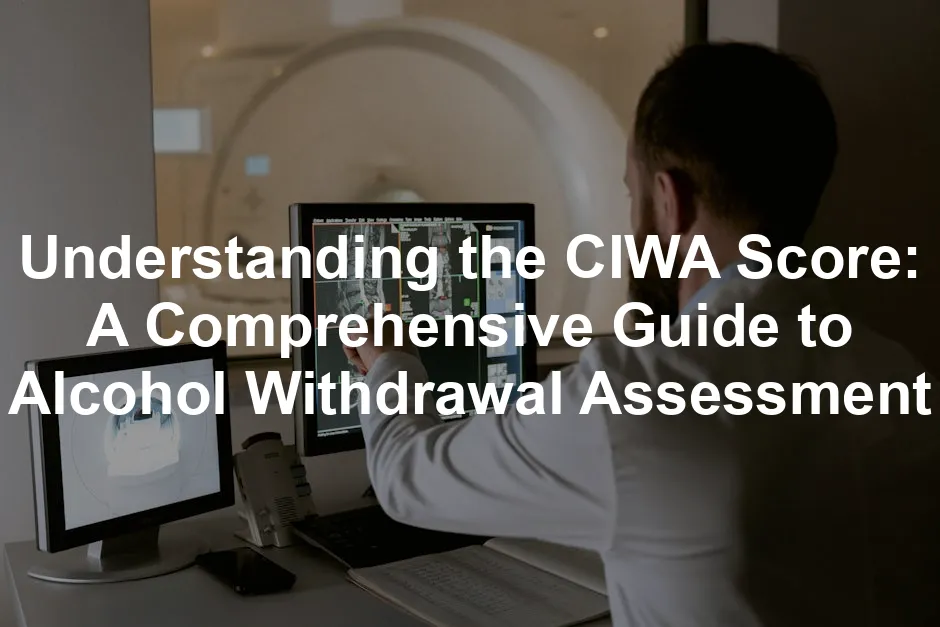Introduction
Alcohol withdrawal can lead to serious health issues. It occurs when someone reduces or stops drinking after heavy use. The symptoms can range from mild to life-threatening. The Clinical Institute Withdrawal Assessment (CIWA) is a vital tool for assessing withdrawal severity. Understanding the CIWA score is crucial for healthcare professionals to provide effective care during this challenging time.
To better manage withdrawal symptoms, consider having a CIWA-Ar Assessment Tool Kit on hand. This kit can streamline the process of evaluating withdrawal symptoms and ensure that you have the right resources available for patient care.
Summary and Overview
The CIWA score is a standardized assessment tool used to evaluate alcohol withdrawal symptoms. Its primary purpose is to gauge the severity of these symptoms, allowing healthcare providers to offer appropriate treatment. The CIWA protocol was first developed to create a consistent method for monitoring withdrawal and has since evolved into the CIWA-Ar version. This revised scale streamlines the assessment process and includes ten specific symptoms, making it simpler to use.

By improving accuracy in identifying symptoms, the CIWA score plays a crucial role in enhancing patient outcomes during alcohol withdrawal treatment. Regular and precise assessments can prevent complications, ensuring patients receive timely interventions. Inaccurate assessments can lead to severe consequences, underscoring the importance of understanding and utilizing the CIWA protocol effectively.
While you’re at it, consider bolstering your knowledge with the Alcohol Withdrawal Management Book. It’s a comprehensive guide that can empower healthcare professionals with the knowledge they need to navigate this challenging process.
What is the CIWA Score?
Definition of CIWA
The Clinical Institute Withdrawal Assessment (CIWA) is a structured tool designed to evaluate alcohol withdrawal symptoms. The CIWA score focuses on ten specific symptoms, including agitation, anxiety, and tremors. Each symptom is scored on a scale from 0 to 7, with higher scores indicating more severe symptoms. This systematic approach allows healthcare professionals to quickly assess the patient’s condition and determine the necessary treatment steps.
History and Development
The CIWA protocol was established in the late 1980s to address the need for a standardized assessment method in alcohol withdrawal management. Initially, it included 30 items, but it has since been revised to the CIWA-Ar version, which consists of ten essential symptoms. Research has shown that using the CIWA protocol effectively reduces complications and improves treatment outcomes. Key studies have demonstrated its efficiency, providing robust support for its widespread use in clinical settings.
Speaking of efficient treatment, having a Benzodiazepine Medication Guide can be a lifesaver for healthcare professionals. It provides crucial information on managing these medications, ensuring safe and effective treatment during withdrawal.
Purpose of the CIWA Score
Assessing Severity of Withdrawal
The CIWA score plays a crucial role in assessing alcohol withdrawal severity. It evaluates various symptoms to determine how intense the withdrawal phase is. By identifying the severity, healthcare providers can anticipate potential complications. This proactive approach is essential; it helps prevent severe outcomes like seizures or delirium tremens. With CIWA, professionals can monitor patients closely and adjust care plans accordingly. This tool fundamentally enhances patient safety and comfort during a challenging time.
Guiding Treatment Decisions
CIWA scores directly inform treatment decisions and interventions. For instance, a higher CIWA score may prompt more aggressive treatment, such as benzodiazepines, while a lower score might allow for supportive care. This adaptability is vital across various clinical settings, including inpatient, outpatient, and emergency departments. In inpatient care, CIWA helps guide continuous monitoring. In outpatient settings, it aids in evaluating ongoing treatment effectiveness. In emergencies, it allows for quick assessments and immediate care, ensuring patients receive timely assistance tailored to their needs.

To help patients relax during this stressful time, consider utilizing a Relaxation Sound Machine. It can create a calming atmosphere that may ease anxiety and promote a sense of well-being for patients undergoing withdrawal.
CIWA Assessment Components
Overview of Symptoms Measured
The CIWA scale measures ten specific symptoms, each vital for understanding alcohol withdrawal. Here’s a brief overview of these symptoms:
- Agitation: Observing restlessness or heightened anxiety.
- Anxiety: Evaluating levels of nervousness or unease.
- Auditory Disturbances: Checking for any hearing issues or hallucinations.
- Clouding of Sensorium: Assessing confusion or difficulty in focusing.
- Headache: Inquiring about the presence and intensity of headaches.
- Nausea/Vomiting: Measuring gastrointestinal distress, including nausea and vomiting.
- Paroxysmal Sweats: Noting excess sweating without physical exertion.
- Tactile Disturbances: Identifying any unusual sensations like itching or tingling.
- Tremor: Observing any shaking, particularly in the hands.
- Visual Disturbances: Evaluating any vision-related issues or hallucinations.
Each symptom is scored from 0 to 7, where 0 indicates no symptoms and 7 represents severe manifestations. This scoring system provides a clear picture of the patient’s condition, allowing for targeted interventions and effective management of withdrawal symptoms.
Administration of the CIWA Assessment
Who Should Administer CIWA?
The CIWA assessment should be conducted by trained healthcare professionals. This includes doctors, nurses, and mental health specialists. Having qualified personnel is crucial for accurate evaluations. Their expertise ensures the assessment is done correctly, leading to appropriate treatment. Training helps providers understand the scoring system and recognize withdrawal symptoms. Consistency in training and application is vital for reliable results.
Standardization in administering the CIWA protocol fosters uniformity across different healthcare settings. It ensures that all patients receive comparable care, minimizing variability in assessments. This is especially important in emergency departments or inpatient settings, where quick, precise evaluations can significantly impact patient outcomes.

Best Practices for Administration
When conducting a CIWA assessment, there are several best practices to follow. First, initiate the assessment promptly when withdrawal symptoms are suspected. Early identification allows for timely interventions, which can prevent complications.
Regular assessments are essential until the patient stabilizes. Re-evaluating symptoms frequently helps track changes in withdrawal severity. This monitoring can guide treatment adjustments based on the patient’s needs.
Ensure the assessment environment is calm and private. A comfortable setting encourages honest responses from the patient. Additionally, involve the patient in the assessment process. Encouraging their input can lead to a more accurate evaluation.
Lastly, document scores and any changes in symptoms meticulously. This record can be invaluable for ongoing treatment and communication within the healthcare team.
Limitations of the CIWA Score
Subjectivity in Scoring
One significant limitation of the CIWA assessment is its subjective nature. The scoring relies heavily on patient self-reports. This can lead to inconsistencies, as patients may have difficulty articulating their symptoms. Factors such as language barriers or cognitive impairments can further complicate accurate scoring.

For example, a patient who is confused may struggle to provide reliable information. This can result in underestimating the severity of withdrawal symptoms. Additionally, cultural differences in expressing discomfort may affect how symptoms are reported.
These factors highlight the need for careful consideration in interpretation. Healthcare providers should remain aware of these limitations to ensure the best possible care. Alternative assessment tools may be necessary when reliability is compromised, ensuring patient safety remains a priority.
Alternative Assessment Tools
While the CIWA score is widely used, there are times it may not be reliable. Factors like language barriers or cognitive impairments can hinder accurate assessments. In such cases, alternative tools become essential.

For instance, the Objective Alcohol Withdrawal Scale (OAWS) is one option. It relies less on patient self-report and focuses more on observable symptoms. This can be particularly useful when communication is challenging. Flexibility in assessment methods is crucial. Different patients have unique needs, and having a range of tools ensures comprehensive care.
By being adaptable, healthcare providers can offer the best support to each individual facing alcohol withdrawal. Also, to support wellness during this process, consider Guided Meditation for Anxiety Relief. It can help patients find their calm and focus amidst the chaos of withdrawal.
Importance of CIWA in Treatment
Impact on Patient Outcomes
Using the CIWA score significantly improves treatment outcomes for those experiencing alcohol withdrawal. Studies indicate that implementing the CIWA protocol reduces the need for medications, such as benzodiazepines. A study published in Hospital Pharmacy found that patients using CIWA required less diazepam without compromising safety. This effectiveness highlights the CIWA’s role in enhancing patient care.

Additionally, hospitals that utilize the CIWA score report lower rates of complications. For example, a review showed that with CIWA, the risk of developing severe withdrawal symptoms decreased. Such statistics underscore the value of this tool in clinical practice.
Role in Treatment Protocols
The CIWA score is integral to treatment protocols for alcohol withdrawal. It helps guide medication administration based on the severity of symptoms. A higher CIWA score typically indicates a need for more aggressive treatment, often involving benzodiazepines.

For example, if a patient scores above 15, clinicians may consider immediate medication to prevent complications like delirium tremens. Conversely, lower scores may allow for supportive care and monitoring. By aligning treatment with CIWA scores, healthcare professionals can provide tailored care that meets patients’ specific needs.
This structured approach not only improves patient comfort but also enhances safety during the withdrawal process. To further support the health of your patients, consider a Herbal Tea Sampler Set to offer soothing options for patients needing relaxation during their recovery.
Conclusion
The CIWA score is essential for assessing alcohol withdrawal. It helps healthcare professionals determine the severity of withdrawal symptoms. Accurate assessment is crucial for enhancing patient care and treatment outcomes. Misjudging the severity can lead to inadequate treatment, resulting in serious complications. Familiarizing oneself with CIWA protocols allows providers to deliver effective and timely interventions. By using CIWA, healthcare teams can better support patients through the challenges of alcohol detoxification. Ultimately, mastering this tool can significantly improve recovery experiences.
FAQs
What is the CIWA score used for?
The CIWA score is primarily used to assess the severity of alcohol withdrawal symptoms. It helps healthcare professionals identify how intense the withdrawal phase is. By evaluating symptoms systematically, providers can determine the best course of action for treatment. This approach minimizes the risks associated with alcohol withdrawal, leading to better patient outcomes.
How is the CIWA score calculated?
The CIWA score is calculated based on ten specific symptoms, each rated between 0 to 7. The symptoms include agitation, anxiety, and tremors, among others. After scoring each symptom, the scores are summed to give a total. A score below 8 indicates mild withdrawal, 8-15 suggests moderate withdrawal, and a score of 16 or higher indicates severe withdrawal, with potential risks like delirium tremens.
Who can administer the CIWA assessment?
The CIWA assessment can be administered by qualified healthcare professionals. This includes doctors, nurses, and mental health specialists who have received proper training. Training ensures that providers understand the scoring system and can accurately evaluate withdrawal symptoms. Consistent administration by trained professionals is vital for reliable results.
What are the limitations of the CIWA score?
One limitation of the CIWA score is its subjective nature. Since it relies on patient self-reports, inconsistencies may arise. Factors such as language barriers or cognitive impairments can affect the accuracy of the assessment. Additionally, some symptoms may be difficult to evaluate without close observation. This highlights the need for careful interpretation and consideration of alternative assessment tools when necessary.
How does CIWA impact treatment outcomes?
Utilizing the CIWA score positively influences treatment outcomes for patients experiencing alcohol withdrawal. Studies show that CIWA-guided protocols can reduce the use of medications like benzodiazepines without compromising safety. Hospitals employing the CIWA score often report lower rates of complications. This structured approach enables healthcare providers to deliver timely and appropriate care, ultimately supporting better recovery experiences.
Healthcare professionals play a critical role in managing patient safety during alcohol withdrawal. For more insights, check out the statistics for healthcare professionals on workplace safety 2024.
As a final touch, don’t forget to keep yourself hydrated and healthy with a Water Bottle with Time Marker. It’s a fun way to ensure you’re drinking enough water throughout your busy day!
Please let us know what you think about our content by leaving a comment down below!
Thank you for reading till here 🙂
All images from Pexels




